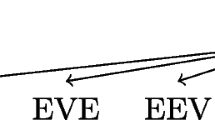Abstract
We estimate the parameters of a Markov chain model using two types of simulated data: micro, or actual interstate transition counts, and macro aggregate frequency. We compare, by means of Monte Carlo experiments, the validity and power for micro likelihood ratio tests with their macro counterparts, previously developed by the authors to complement standard least-squares point estimates. We consider five specific null hypotheses, including parameter stationarity, entity homogeneity, a zero-order process, a specified probability value, and equal diagonal probabilities. The results from these micro-macro comparisons should help to indicate whether micro panel data collection is justified over the use of simpler state frequency counts.
Similar content being viewed by others
References
I.G. Adelman, A stochastic analysis of the size distribution of firms, J. Amer. Statist. Assoc. 53(1958)893.
T.W. Anderson and L.A. Goodman, Statistical inference about Markov chains, Ann. Math. Statist. 28(1957)89.
I.V. Basawa and B.L.S. Prakasa Rao,Statistical Inference for Stochastic Processes (Academic Press, London, 1980).
F.K. Bedall, Test statistics for simple Markov chains. A Monte Carlo study, Biometrical Journal 20(1978)41.
P. Billingsley,Statistical Inference for Markov Processes (The University of Chicago Press, Illinois, 1961).
P. Billingsley, Statistical methods in Markov chains, Ann. of Math. Statist. 32(1961)12.
G.E.P. Box, W.G. Hunter and J.S. Hunter,Statistics for Experimenters (Wiley, New York, 1978).
G.C. Chow, Tests of equality between sets of coefficients in two linear regressions, Econometrica 28(1960)591.
L. Collins,Industrial Migration in Ontario: Forecasting Aspects of Industrial Activity through Markov Chain Analysis (Statistics Canada, Ottawa, 1972).
N.R. Collins and L.E. Preston, The size structure of industrial firms, American Economic Review 51(1961)986.
F.M. Fisher, Tests of equality between sets of coefficients in two linear regressions. An expository note, Econometrica 38(1970)361.
J.D. Kalbfleisch and J.F. Lawless, Least-squares estimation of transition probabilities from aggregate data, Can. J. Statist. 12(1984)169.
J.D. Kalbfleisch, J.F. Lawless and W.M. Vollmer, Estimation in Markov models from aggregate data, Biometrics 39(1983)907.
C.M.L. Kelton, Estimation of time-independent Markov processes with aggregate data: A comparison of techniques, Econometrica 49(1981)517.
C.M.L. Kelton, Nonstationary Markov modeling: An application to wage-influenced industrial relocation, Int. Regional Science Review 9(1984)75.
C.M.L. Kelton and W.D. Kelton, Advertising and intra-industry brand shift in the U.S. brewing industry, J. of Industrial Economics 30(1982)293.
C.M.L. Kelton and W.D. Kelton, Development of specific hypothesis tests for estimated Markov chains, J. of Statistical Computation and Simulation (1984), to appear.
C.M.L. Kelton and W.D. Kelton, Markov process models: A general framework for estimation and inference in the absence of state transition data, in:Mathematical Modelling in Science and Technology, Proc. 4th Int. Conf. on Mathematical Modelling, ed. X.J. Avula et al. (Pergamon Press, Zurich, 1984) p. 299.
W.D. Kelton and C.M.L. Kelton, Hypothesis tests for Markov process models estimated from aggregate frequency data, J. Amer. Statist. Assoc. 79(1984)922.
S. Kullback, M. Kupperman and H.H. Ku, Tests for contingency tables and Markov chains, Technometrics 4(1962)573.
J.F. Lawless and D.L. McLeish, The information in aggregate data from Markov chains, Biometrika 71(1984)419.
T.C. Lee, G.G. Judge and A. Zellner,Estimating the Parameters of the Markov Probability Model from Aggregate Time Series Data, 2nd ed. (North-Holland, Amsterdam, 1977).
W.F. Lever, The intra-urban movement of manufacturing: A Markov approach, Transactions, Institute of British Geographers 56(1972)21.
P.A.W. Lewis, A.S. Goodman and J.M. Miller, A pseudo-random number generator for the system/360, IBM Systems Journal 8(1969)136.
E.C. MacRae, Estimation of time-varying Markov processes with aggregate data, Econometrica 45(1977)183.
A. Madansky, Least squares estimation in finite Markov processes, Psychometrika 24 (1959) 137.
J. Meredith, Selecting optimal training programs in a hospital for the mentally retarded, Oper. Res. 24(1976)899.
G.A. Miller, Finite Markov processes in psychology, Psychometrika 17(1952)149.
B.K. Shah, Data analysis problems in the area of pharmacokinetics research, Biometrics 32(1976)145.
S. Spilerman, The analysis of mobility processes by the introduction of independent variables into a Markov chain, American Sociological Review 37(1972)277.
M.A. Stephens, EDF statistics for goodness of fit and some comparisons, J. Amer. Statist. Assoc. 69(1974)730.
L.G. Telser, Advertising and cigarettes, The Journal of Political Economy 70(1962)471.
L.G. Telser, The demand for branded goods as estimated from consumer panal data, The Review of Economics and Statistics 44(1962)300.
H. Theil,Principles of Econometrics (Wiley, New York, 1971).
F.H. Trinkl, A stochastic analysis of programs for the mentally retarded, Oper. Res. 22(1974)1175.
A.P. Van der Plas, On the estimation of the parameters of Markov probability models using macro data, Ann. of Statist. 11(1983)78.
S.J. Yakowitz, A stochastic model for daily river flows in an arid region, Water Resources Research 9(1973)1271.
S.J. Yakowitz, Small-sample hypothesis tests of Markov order, with application to simulated and hydrologic chains, J. Amer. Statist. Assoc. 71(1976)132.
Author information
Authors and Affiliations
Rights and permissions
About this article
Cite this article
Kelton, C.M.L., Kelton, W.D. Comparison of hypothesis testing techniques for markov processes estimated from micro versus macro data. Ann Oper Res 8, 175–194 (1987). https://doi.org/10.1007/BF02187090
Issue Date:
DOI: https://doi.org/10.1007/BF02187090




